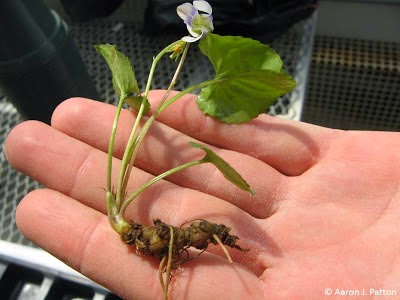 |
| Wild violets |
- A clumping growth habit
- Heart shape leaves that cup toward the petiole
- Dense fibrous root system
- Prefers shaded site with moist fertile soil
 |
| Wild violet rhizome on soil surface |
 | ||
| Violet rhizome after washing off soil |
Violets are one of the toughest lawn weeds to control. They spread aggressively by thick, fleshy underground stems (rhizomes) that provide a large reserve of nutrients. This ability to store nutrients allows them to reappear after you attempt to kill them. Violets can be controlled, but you have to go after them aggressively and it is a process, not a one-shot treatment
For small areas hand pulling or weeding is laborious, but it’s the best way to control violets. When pulling be sure that you get the whole root, which includes the seed-bearing capsules near the soil's surface. In lawns, use a sharp knife to sever roots before pulling up the plants
Fall is the one of best times of year to control the wild violets. Use a broadleaf killer that contains 2,4-D or Dicamba, and it will selectively kill the violets without damaging certain types of grass.
Always, read the label before applying herbicides, it’s the law. Make sure the weed you are targeting for control is really causing a problem. Choose the right herbicide and always follow label directions when applying herbicides. The label lists the areas or locations where you can legally apply the herbicide, what protective clothing must be worn, how to mix the herbicide and other important information. Wear the protective clothing the label requires to minimize exposure during mixing, application and clean up.
Additional Information
May's Weed of the Month Wild Violets - Purdue University Extension
Wild Violet - University of Maryland Extension
Wild Violet Control - University of Nebraska